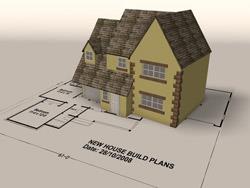South African nominal house price growth in the middle segment of the housing market is forecast to remain relatively low in 2012.

Absa says in real terms, house prices are set to deflate further in 2012 based on expected low nominal price growth and headline consumer price inflation which is set to remain above the 6 percent level.
This has been revealed in the Absa Home Loans Housing Review Q1 2012.
The bank says in real terms, house prices are set to deflate further in 2012 based on expected low nominal price growth and headline consumer price inflation which is set to remain above the 6 percent level.
Writing in the report, Jacques du Toit, Absa Home Loans property analyst says the continued subdued performance expected from property prices will be the result of developments and forecasts with regard to the macro economy and the household sector.
Absa expects the South African economy is forecast to grow by 2.8 percent in 2012.
The lower growth expected this year will largely be the result of a slower pace of expansion projected for the world economy, which will affect South Africa’s export performance.
A weaker rand exchange rate in 2012 compared with last year will, however, support the country’s export earnings.
Trends in domestic inflation and interest rates will also impact the economy during the course of the year.
Click here to read more about economic growth prospects by some of South Africa’s top economists and here about what others have to say about house prices.
Du Toit notes that a fair percentage of consumers are still battling with impaired credit records adversely affecting their access to credit.
The report indicates that in 2011 nominal house price growth was lower compared with 2010 while in real terms, house prices were on average lower than in 2010.
“Real year-on-year (y/y) house price deflation accelerated marginally in the Q4 2011 on the back of rising inflation during this period.”
He explains that despite the upward trend in inflation during the course of 2011, lending rates were kept unchanged throughout the year.
Real household disposable income increased at an annualised 3.9 percent in Q3 2011 from 3.5 percent in Q2 2011.
The y/y growth in household credit extension, comprising instalment sales credit, leasing finance, mortgage advances, credit card debt, overdrafts and general loans and advances (mainly personal and micro loans) slowed down further towards the end of 2011.
Residential building activity improved in the first 11 months of 2011 compared with 2010 and is set to be reflected in a higher level of residential investment in 2012.

The y/y growth in household credit extension, comprising instalment sales credit, leasing finance, mortgage advances, credit card debt, overdrafts and general loans and advances (mainly personal and micro loans) slowed down further towards the end of 2011.
Growth in the value of outstanding household mortgage balances was around 1 percent y/y towards the end of 2011.
The value of new mortgage loans granted by banks in respect of residential property was down by 33 percent y/y in the third quarter of 2011, says Du Toit.
The cost of servicing household mortgage debt as a percentage of disposable income was unchanged at around 4 percent in the third quarter of last year compared with the second quarter.
Looking at some house trends in 2011, Absa found that:
- in real terms, house prices were on average lower than in 2010
- interest rate movements affected debt repayments including mortgage repayments. The current variable mortgage rate of 9 percent has the effect of monthly mortgage repayments being 33.5 percent lower compared with early December 2008 when the mortgage rate was 15.5 percent
Absa expects interest rates to remain at current levels until late this year before being hiked on the back of inflationary pressures.
- many consumers are still over indebted affecting the accessibility of credit
- consumer confidence was relatively low
He says the house price trends referred to in the report are based on the value of homes for which Absa received applications and approved mortgage finance.
In 2011, the average price of affordable housing (houses measuring between 40 to 79 square metres and priced up to R480 000) rose by a nominal 2.4 percent (5.2 percent in 2010).
This translated into a real price decline of 2.5 percent in 2011 after an increase of 0.9 percent in 2010.
He says in Q4 2011, the average nominal price of affordable houses increased by 4.4 percent y/y to about R321 600 with price growth of 2.2 percent y/y recorded in the third quarter.
In real terms, house prices in the affordable segment declined by 1.6 percent y/y in Q4 2011 compared with a real price decline of 3.1 percent y/y recorded in the preceding quarter.
The average value of houses in the middle segment of the market (80 to 400 square metres and priced at R3.5 million or less) was up by 2.2 percent (7.3 percent in 2010).
Real price deflation of 2.7 percent was registered in 2011, after prices increased by a real 2.9 percent in 2010.

In real terms, house prices in the affordable segment declined by 1.6 percent y/y in Q4 2011 compared with a real price decline of 3.1 percent y/y recorded in the preceding quarter.
In Q4 2011, middle-segment home values were up by 4.8 percent y/y in nominal terms (4.3 percent y/y in Q3 2011), which brought the average house price to a level of about R1 071 400 in the quarter.
In real terms, house prices in the middle segment dropped by 1.3 percent y/y in Q4 2011 (-1.1 percent y/y in Q3 2011).
Small houses recorded a price growth of -4.2 percent y/y nominal and -8.7 percent real terms, medium houses 1.7 percent y/y nominal and -3.2 percent y/y in real terms while large houses grew by 3.2 percent y/y nominal and -1.8 percent y/y in real terms.
The luxury house segment (priced between R3 million and R12.8 million) recorded nominal house price growth of 1.9 compared with price growth of 3.8 percent in 2010.
He says house prices in this category were on average down by a real 3 percent in 2011 after declining by 0.4 percent in 2010.
The average nominal price of luxury housing dropped by 3.3 percent y/y in Q4 2011 (+1.7 percent y/y in the preceding quarter) while in real terms, prices were down by an average 8.9 percent y/y in Q4 2011 (-3.5 percent y/y in the third quarter).
Regional house prices
Some provinces recorded house price growth while others real price declined in 2011 when compared to 2010.
Du Toit points out that although affected by general economic trends, the residential property market at regional level is also influenced by area-specific factors and developments.
In the Free State, house prices were up by a nominal of 6.4 percent (1.3 percent in real terms), Mpumalanga, a nominal of 5.8 percent (0.7 percent in real terms), Gauteng, 3.7 percent nominal (-1.3 percent in real terms), KwaZulu-Natal, up by 3.5 percent in nominal terms (-1.4 percent in real terms), Northern Cape, 1.9 percent nominal terms (-2.9 percent in real terms), North West, 1.1 percent nominal (-3.7 percent in real terms), Limpopo, down by a nominal 0.6 percent (-5.3 percent in real terms), Western Cape, down by 1.4 percent nominal (-6.1 in real terms) and the Eastern Cape down by a nominal 1.5 percent (-6.2 percent in real terms).

In the Free State, house prices were up by a nominal of 6.4 percent (1.3 percent in real terms), Mpumalanga, a nominal of 5.8 percent (0.7 percent in real terms), Gauteng, 3.7 percent nominal (-1.3 percent in real terms), KwaZulu-Natal, up by 3.5 percent in nominal terms (-1.4 percent in real terms), Northern Cape, 1.9 percent nominal terms (-2.9 percent in real terms), North West, 1.1 percent nominal (-3.7 percent in real terms), Limpopo, down by a nominal 0.6 percent (-5.3 percent in real terms), Western Cape, down by 1.4 percent nominal (-6.1 in real terms) and the Eastern Cape down by a nominal 1.5 percent (-6.2 percent in real terms).
The performance of middle-segment house prices in the major metropolitan areas was as follows in 2011:
- Greater Johannesburg: 5.5 percent higher in nominal terms (-0.5 percent in real terms)
- Bloemfontein: 2.5 percent higher in nominal terms (-2.4 percent in real terms)
- Pretoria up by 2.1 percent in nominal terms (-2.8 percent in real terms)
- Durban up by a nominal 1.2 percent (-3.6 percent in real terms)
- Cape Town down by 1.1 percent in nominal terms (-5.8 percent in real terms)
- Port Elizabeth/Uitenhage down by a nominal 3.2 percent (-7.8 percent in real terms)
- East London down by 4.8 percent in nominal terms (-9.4 percent in real terms).
Coastal regions
In the coastal areas, the average price of houses of between 80 square metres and 700 square metres priced up to R12.8 million increased in nominal terms in 2011 compared with 2010 but was lower in real terms.
In 2011, house price growth in the coastal regions recorded a 2.2 percent in nominal terms (-2.7 percent in real terms).
KwaZulu-Natal was up by a nominal 7.7 percent (2.6 percent in real terms), Western Cape 3.4 percent higher in nominal terms (-1.5 percent in real terms) and the Eastern Cape recorded 0.1 percent in nominal terms (-4.7 percent in real terms).
Building costs
Absa says the cost of having a new middle-segment house built was up by a nominal 5.3 percent compared with 8 percent in 2010.
“In view of this increase in building costs, the average nominal price of a new house was a nominal 6.6 percent higher at a level of about R1 516 400 last year.”
Du Toit says this translated into real price growth of 1.5 percent in the past year.
The average nominal price of an existing house came to about R1 037 800 in 2011 (up by 1.8 percent in nominal terms and down by 3.1 percent in real terms compared with 2010).
He says this made it R478 600 or 31.6 percent cheaper to have bought an existing house than to have built a new house in 2011.
In Q4 2011, the cost of building a new house was up by a nominal 6.1 percent y/y (5.3 percent y/y in Q3 2011), which was in line with the average headline consumer price inflation rate in the quarter.
The average nominal price of a new house increased by 7.3 percent y/y to about R1 596 600 in Q4 2011 translating into a real increase of 1.1 percent y/y.
The average price of an existing house was up by a nominal 4 percent y/y to about R1 045 600 in the fourth quarter, which came to a real decline of 2 percent y/y in the quarter.
He says it was R551 000 or 34.5 percent cheaper to have bought an existing house than to have a new one built in Q4 2011.

Factors impacting building costs and eventually the price of new housing include material costs, equipment costs, transport costs, labour costs, developer and contractor profit margins and the cost of developing land for residential purposes.
Factors impacting building costs and eventually the price of new housing include material costs, equipment costs, transport costs, labour costs, developer and contractor profit margins and the cost of developing land for residential purposes.
On land, he says this is impacted by aspects such as scarcity, the availability of services, the cost of rezoning and the demolition of old and unwanted structures where applicable.
The report indicates that the average land value for new housing in the middle and luxury segments of the market for which Absa received applications and approved mortgage finance dropped by a nominal 1.1 percent to about R493 500 in 2011 from 10.4 percent in 2010.
In real terms land values were down by 5.9 percent in 2011 (+5.8 percent in 2010).
In Q4 2011, the average value of vacant land for new housing was down by 1 percent y/y to R493 900 while in real terms prices dropped by 6.7 percent y/y in the quarter.
Absa says growth in real household disposable income is forecast to slow down to 3.7 percent in 2012 impacted by lower economic growth.
Du Toit adds that the residential property market is expected to continue to reflect conditions and developments in the macro economy and the household sector, impacting market activity, transaction volumes and price trends. –Denise Mhlanga









